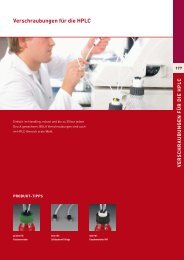You also want an ePaper? Increase the reach of your titles
YUMPU automatically turns print PDFs into web optimized ePapers that Google loves.
MECHANICAL STABILITY OF SIMAX GLASSMechanical properties and service life of products made of the SIMAX glass are largely done by the stageof their finish, especially in their entirety, i.e. depth failure on surface in manipulation and secondary thermaltreatment.Glass mass scratch hardness of 6 ° of Mohs scaleAdmissible tensile stress3.5 MPaAdmissible bending stress7.0 MPaAdmissible compressive stress100.0 MPaTHERMAL PROPERTIES OF SIMAX GLASSHigh resistance of product made of the SIMAX glass to sudden change in temperature – heat stability – isdone by low coefficient of linear thermal expansion, relatively low modulus of tensile elasticity, as well asrelatively high thermal conductivity resulting in a lower thermal gradient in the product wall.On cooling and heating the glass product, an undesirable internal stress arises. Breakage of the glass productdue to temperature change is caused by tensile stress on the product surface arising due to action oflinear dilatability of the glass on quick cooling from the product surface.With a mechanical failure in the product surface, the heat stability can be significantly reduced.Wall thickness (in mm)Resistance to heat shock (D °C)1 3033 1756 12410 96The manufacturer may perform an exact calculation, where necessary.COOLING OF SIMAX GLASSTemperature rangeCooling represents a thermal process the purpose of which is keeping from formation of undesirable andinadmissibly high thermal stress in the glass which would reduce the product resistance, and/or removingof stress already arisen.Cooling cycle comprises three stages:• Temperature increase (product heating) with heating rate from the inlet temperature to the upper coolingvalue.• Dwell (pause, tempering, stabilization) of products at upper cooling temperature for certain time whenthe temperature differences in the product must be equalized, including stress reduction to an admissiblelimit.• Temperature decrease (cooling and additional cooling) of the product with cooling rate from the upperto the lower cooling value (this stage is important as the permanent stress can arise), and from the lowercooling temperature to the final value or ambient temperature (important for subsequent practical manipulationwith the product).Concrete cooling cycle is specified in the table.Maximum wall thicknessRise Dwell Temperature Drop20–550 °C 560 °C 560–490 °C 490–440 °C 440–40 °C3 mm 140 °C/min 5 °C/min 14 °C/min 28 °C/min 140 °C/min6 mm 30 °C/min 10 °C/min 3 °C/min 6 °C/min 30 °C/min9 mm 15 °C/min 18 °C/min 1,5 °C/min 3 °C/min 15 °C/min12 mm 8 °C/min 30 °C/min 0,6 °C/min 1,6 °C/min 8 °C/minOPTICAL PROPERTIES OF SIMAX GLASSThe Glass SIMAX is transparent and clear; it does not show substantial absorption in visible spectrum.Permeability of ultra-violet rays enables the products made of the SIMAX glass to be used for photochemicalreactions.Refractive index (λ = 587.6 nm) n d1.473Photoelastic constant (DIN 52314) K 4.0.10 —6 mm 2 .N —13




